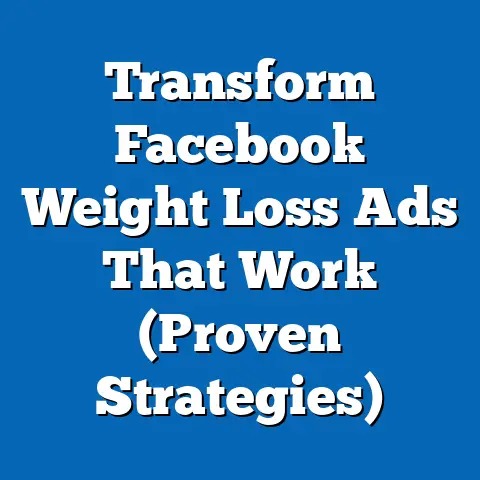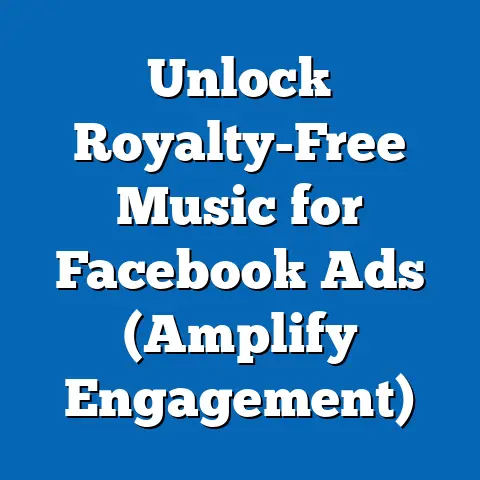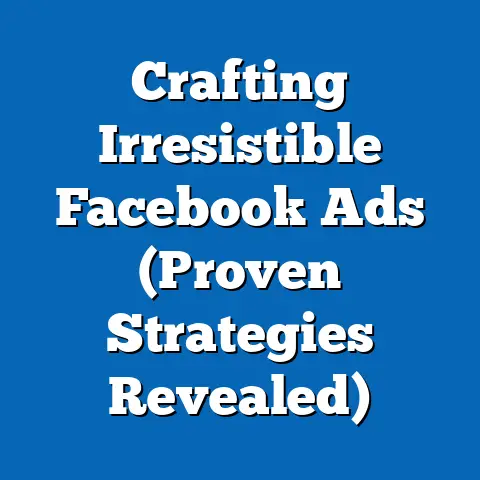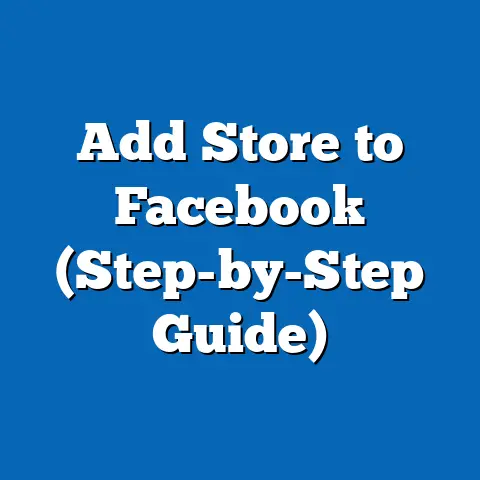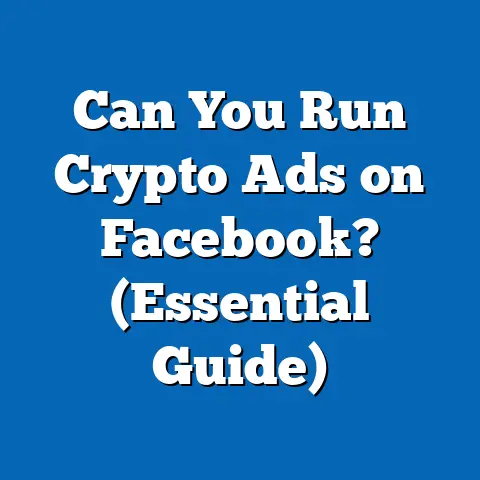Supercharge Freelance Facebook Ads (Proven Strategies)
As a freelancer, I know how crucial it is to make every dollar count. I’ve been there, pouring over budgets, trying to figure out how to reach the right clients without breaking the bank. And let me tell you, in today’s digital landscape, mastering Facebook advertising is no longer optional – it’s a necessity. It’s a skill that can lead to long-term savings and dramatically increased profitability. Imagine attracting a steady stream of high-quality leads, all thanks to strategically crafted and optimized Facebook ads. That’s the power we’re talking about.
The freelance world is fiercely competitive. Standing out from the crowd requires more than just talent; it demands strategic marketing. Effective Facebook advertising allows you to target your ideal clients with laser precision, showcasing your skills and services to those who need them most. This means less wasted ad spend and more qualified leads knocking on your digital door.
This article is your roadmap to unlocking the full potential of Facebook ads. I’m going to share proven strategies specifically tailored for freelancers like you, equipping you with the knowledge and tools to create campaigns that deliver real results. We’ll dive deep into understanding the Facebook Ads ecosystem, defining your ideal audience, crafting compelling ad copy, mastering budgeting and bidding, and analyzing performance for continuous optimization. Get ready to transform your freelance business with the power of Facebook advertising!
Understanding the Facebook Ads Ecosystem
Before you start throwing money at Facebook, it’s crucial to understand the landscape. I remember when I first started, I was so overwhelmed by all the options and jargon. Don’t worry, I’m going to break it down for you.
Think of Facebook Ads as a complex, yet powerful, machine. Its success hinges on several key components:
- Targeting: This is where you define who you want to see your ads. You can target based on demographics (age, location, gender), interests (hobbies, pages they like), behaviors (purchase history, online activity), and even custom audiences (email lists, website visitors).
- Ad Placements: This refers to where your ads will appear. Facebook offers a variety of placements, including the Facebook News Feed, Instagram Feed, Audience Network (websites and apps outside of Facebook), Messenger, and more.
- Bidding: This is how you tell Facebook how much you’re willing to pay for each desired action (e.g., a click, an impression, a conversion). There are different bidding strategies to choose from, such as lowest cost, cost cap, and value-based bidding.
- Analytics: This is where you track the performance of your ads and see what’s working and what’s not. Facebook provides a wealth of data, allowing you to measure key metrics like reach, impressions, click-through rate, conversion rate, and return on ad spend.
The Facebook Ads Manager is your control panel. This is where you create, manage, and analyze your campaigns. It might seem intimidating at first, but trust me, it’s your best friend. Take the time to explore the interface, familiarize yourself with the different features, and don’t be afraid to experiment. The more comfortable you are with Ads Manager, the more effectively you can manage your campaigns.
Facebook offers a diverse range of ad formats to suit different objectives and target audiences. Here are some of the most common types:
- Image Ads: These are simple, visually appealing ads that feature a single image and accompanying text. They’re great for building brand awareness and driving traffic to your website.
- Video Ads: Video ads are highly engaging and can be used to tell a story, showcase your services, or provide valuable information. They’re particularly effective for capturing attention in a crowded news feed.
- Carousel Ads: Carousel ads allow you to display multiple images or videos in a single ad unit. This format is ideal for showcasing a range of products or services or highlighting different aspects of your expertise.
- Collection Ads: These ads are designed for e-commerce businesses and allow users to browse and purchase products directly from the ad. While less relevant for most freelancers, they can be useful if you sell digital products or offer online courses.
- Lead Generation Ads: These ads allow you to collect leads directly on Facebook, without requiring users to visit your website. They’re great for building your email list or generating inquiries for your services.
Choosing the right ad format is crucial for achieving your campaign goals. Consider your target audience, the type of message you want to convey, and the desired action you want users to take.
Key Takeaway: Understanding the Facebook Ads ecosystem is the foundation for successful advertising. Familiarize yourself with the key components, explore the Ads Manager interface, and choose the right ad format for your objectives.
Defining Your Target Audience
I can’t stress this enough: knowing your audience is everything. I learned this the hard way. Early on, I ran a campaign targeting “small business owners.” Sounds broad, right? It was! My results were terrible because I wasn’t speaking to anyone specific.
Audience segmentation is the process of dividing your target market into smaller, more defined groups based on shared characteristics. This allows you to create highly targeted ad campaigns that resonate with specific segments, leading to higher engagement and conversion rates.
Here are some tools and methods for researching and defining your target audience:
- Facebook Audience Insights: This tool provides valuable data about the demographics, interests, and behaviors of Facebook users. You can use it to explore potential target audiences and identify relevant characteristics.
- Google Analytics: If you have a website, Google Analytics can provide insights into the demographics, interests, and behaviors of your website visitors. This information can be used to inform your Facebook ad targeting.
- Customer Surveys: Conducting surveys with your existing clients can provide valuable insights into their needs, pain points, and motivations. This information can be used to create buyer personas that resonate with potential clients.
- Competitor Analysis: Analyzing your competitors’ target audiences can provide valuable clues about potential target markets. Look at who they’re targeting on Facebook and what types of messages they’re using.
Buyer personas are fictional representations of your ideal clients. They are based on research and data about your target audience and provide a detailed picture of their demographics, interests, behaviors, and motivations.
Creating buyer personas is a powerful way to humanize your target audience and ensure that your ad campaigns are relevant and engaging. When creating buyer personas, consider the following:
- Demographics: Age, gender, location, education, income
- Interests: Hobbies, passions, activities
- Behaviors: Online activity, purchase history, social media usage
- Pain Points: Challenges, frustrations, needs
- Goals: Aspirations, desires, objectives
Once you have a well-defined buyer persona, you can use it to inform your ad targeting, ad copy, and visual design. This will help you create ads that resonate with your target audience and drive results.
Key Takeaway: Don’t skip this step! Take the time to research and define your target audience. Create detailed buyer personas that reflect their needs, pain points, and motivations. This will enable you to create highly targeted ad campaigns that deliver real results.
Crafting Compelling Ad Copy and Visuals
Okay, you know your audience, now you need to speak their language. I’ve learned that the best ads aren’t just pretty; they’re persuasive.
Persuasive ad copy is essential for capturing attention and driving action. Here are some key elements to consider:
- Headlines: Your headline is the first thing people will see, so make it count. It should be attention-grabbing, relevant, and concise. Use strong verbs, ask a question, or offer a solution to a problem.
- Descriptions: Your description provides additional details about your offer and encourages users to take action. Highlight the benefits of your services, address their pain points, and create a sense of urgency.
- Calls to Action (CTAs): Your CTA tells users what you want them to do next. Use clear and concise language, such as “Learn More,” “Get a Quote,” or “Contact Us.” Make sure your CTA is visually prominent and easy to click.
Visuals play a crucial role in Facebook ads. They’re the first thing people see, and they can make or break your campaign. Here are some tips for creating eye-catching visuals:
- Use High-Quality Images and Videos: Avoid blurry or pixelated images. Use high-resolution images and videos that are visually appealing and relevant to your message.
- Use Bright Colors and Contrasting Text: Bright colors can help your ads stand out in a crowded news feed. Use contrasting text to ensure that your message is easy to read.
- Showcase Your Personality: Let your personality shine through in your visuals. Use images and videos that reflect your unique style and brand.
- Keep it Simple: Avoid cluttering your visuals with too much text or graphics. Keep it simple and focused on your key message.
- A/B Test Your Visuals: Experiment with different images and videos to see what resonates best with your target audience.
Here are some examples of high-performing ad copy and visuals that freelancers can emulate:
- Example 1: Freelance Writer
- Headline: “Tired of Content That Doesn’t Convert?”
- Description: “I help businesses create engaging and persuasive content that drives results. Get a free consultation today!”
- Visual: A professional headshot of the writer with a clean and modern background.
- Example 2: Freelance Web Designer
- Headline: “Stunning Websites That Convert Visitors Into Customers”
- Description: “I specialize in creating custom websites that are both beautiful and functional. Contact me today for a free quote!”
- Visual: A carousel ad showcasing examples of the web designer’s best work.
- Example 3: Freelance Social Media Manager
- Headline: “Stop Wasting Time on Social Media! Let Me Handle It For You.”
- Description: “I help businesses grow their social media presence and drive engagement. Get a free social media audit today!”
- Visual: A video ad showcasing the social media manager’s expertise and results.
- Headline: “Tired of Content That Doesn’t Convert?”
- Description: “I help businesses create engaging and persuasive content that drives results. Get a free consultation today!”
- Visual: A professional headshot of the writer with a clean and modern background.
- Headline: “Stunning Websites That Convert Visitors Into Customers”
- Description: “I specialize in creating custom websites that are both beautiful and functional. Contact me today for a free quote!”
- Visual: A carousel ad showcasing examples of the web designer’s best work.
- Headline: “Stop Wasting Time on Social Media! Let Me Handle It For You.”
- Description: “I help businesses grow their social media presence and drive engagement. Get a free social media audit today!”
- Visual: A video ad showcasing the social media manager’s expertise and results.
Key Takeaway: Craft compelling ad copy and visuals that capture attention, highlight the benefits of your services, and encourage users to take action. Use high-quality images and videos, write clear and concise headlines and descriptions, and include a strong call to action.
Budgeting and Bidding Strategies
Budgeting and bidding are two sides of the same coin. I’ve seen freelancers overspend and underspend, both leading to disappointing results. The key is to find the sweet spot.
Here are some common budgeting strategies for freelancers:
- Daily Budget: This is the average amount you’re willing to spend on your ads each day. It’s a good option if you want to control your spending on a daily basis.
- Lifetime Budget: This is the total amount you’re willing to spend on your ads over the entire duration of your campaign. It’s a good option if you have a fixed budget and want to ensure that you don’t overspend.
Understanding the Cost-Per-Click (CPC) model is crucial for budgeting effectively. CPC is the amount you pay each time someone clicks on your ad. The higher your CPC, the more expensive it will be to drive traffic to your website or landing page.
Setting competitive bids without overspending requires careful planning and analysis. Here are some tips:
- Start with a Low Bid: Start with a low bid and gradually increase it until you start seeing results.
- Use Automatic Bidding: Facebook’s automatic bidding feature can help you optimize your bids based on your campaign goals.
- Monitor Your Performance: Monitor your ad performance closely and adjust your bids as needed.
- A/B Test Your Bids: Experiment with different bids to see what works best for your target audience.
A/B testing is a powerful way to refine your budget allocation and optimize your ad performance. It involves creating two versions of your ad (A and B) and testing them against each other to see which one performs better.
You can A/B test different aspects of your ads, such as:
- Headlines: Try different headlines to see which one captures the most attention.
- Descriptions: Experiment with different descriptions to see which one generates the most clicks.
- Visuals: Test different images and videos to see which ones resonate best with your target audience.
- Bids: Experiment with different bids to see which one delivers the best results.
By analyzing your ad performance, you can make informed decisions about budget adjustments. Here are some key metrics to track:
- Reach: The number of people who saw your ad.
- Impressions: The number of times your ad was displayed.
- Click-Through Rate (CTR): The percentage of people who clicked on your ad after seeing it.
- Conversion Rate: The percentage of people who completed a desired action (e.g., filled out a form, made a purchase) after clicking on your ad.
- Return on Ad Spend (ROAS): The amount of revenue you generated for every dollar you spent on ads.
Key Takeaway: Budget wisely and bid strategically. Understand the CPC model, start with a low bid, use automatic bidding, monitor your performance, and A/B test your bids. Analyze your ad performance regularly and make informed decisions about budget adjustments.
Analyzing and Optimizing Ad Performance
You’ve launched your campaign, but the work doesn’t stop there. I always tell freelancers that advertising is an ongoing process of analysis and optimization.
Key Performance Indicators (KPIs) are metrics that measure the success of your ad campaigns. Here are some of the most important KPIs for freelancers to track:
- Click-Through Rate (CTR): This is the percentage of people who click on your ad after seeing it. A high CTR indicates that your ad copy and visuals are compelling and relevant to your target audience.
- Conversion Rate: This is the percentage of people who complete a desired action (e.g., filled out a form, made a purchase) after clicking on your ad. A high conversion rate indicates that your landing page or sales funnel is effective.
- Cost Per Conversion: The cost per conversion is the amount you pay for each desired action. A low cost per conversion indicates that your ad campaigns are efficient.
- Return on Ad Spend (ROAS): This is the amount of revenue you generated for every dollar you spent on ads. A high ROAS indicates that your ad campaigns are profitable.
Facebook Insights is a powerful tool for evaluating ad performance and making data-driven decisions. Here’s a step-by-step guide on how to use it:
- Log in to Facebook Ads Manager.
- Select the ad campaign you want to analyze.
- Click on the “Insights” tab.
- Choose the date range you want to analyze.
- Review the key metrics, such as reach, impressions, CTR, conversion rate, and ROAS.
- Analyze the demographic data to see who is responding to your ads.
- Use the data to identify areas for improvement.
Once you have analyzed your ad performance, you can start implementing advanced optimization techniques to maximize ad efficiency. Here are some tips:
- Retargeting Ads: Retargeting ads allow you to show ads to people who have previously interacted with your website or Facebook page. This is a great way to re-engage potential clients who have shown interest in your services.
- Lookalike Audiences: Lookalike audiences allow you to target new people who are similar to your existing clients. This is a great way to expand your reach and find new potential clients.
- A/B Testing: A/B testing allows you to experiment with different aspects of your ads to see what works best. This is a great way to optimize your ad copy, visuals, and targeting.
- Ad Scheduling: Ad scheduling allows you to show your ads during the times of day when your target audience is most active. This can help you improve your ad performance and reduce your costs.
Key Takeaway: Continuously analyze and optimize your ad performance. Track key performance indicators, use Facebook Insights to evaluate your results, and implement advanced optimization techniques to maximize ad efficiency.
Case Studies and Success Stories
I’ve shared a lot of strategies, but nothing is as inspiring as seeing them in action. Here are a few real-life examples of freelancers who have successfully implemented Facebook ads to grow their business:
- Case Study 1: Freelance Graphic Designer
A freelance graphic designer wanted to attract more clients for her branding services. She created a Facebook ad campaign targeting small business owners in her local area. Her ad featured a carousel of her best branding projects and a compelling call to action: “Get a Free Branding Consultation.”
The results were impressive. She generated over 50 leads in the first month and landed five new clients, resulting in a significant increase in her revenue.
- Case Study 2: Freelance Virtual Assistant
A freelance virtual assistant wanted to expand her client base and offer her services to a wider audience. She created a Facebook ad campaign targeting busy entrepreneurs who needed help with administrative tasks. Her ad featured a video testimonial from one of her satisfied clients and a clear call to action: “Schedule a Free Consultation.”
The results were outstanding. She generated over 100 leads in the first month and landed ten new clients, significantly expanding her business.
- Case Study 3: Freelance Copywriter
A freelance copywriter wanted to attract more clients for his website copywriting services. He created a Facebook ad campaign targeting businesses that were struggling to generate leads from their websites. His ad featured a compelling headline: “Is Your Website Turning Visitors Away?” and a clear call to action: “Get a Free Website Audit.”
The results were remarkable. He generated over 200 leads in the first month and landed 15 new clients, transforming his business.
These case studies highlight the power of Facebook ads for freelancers. By implementing the strategies outlined in this article, you can achieve similar results and grow your business.
Key Takeaway: Success is attainable! Learn from real-life examples of freelancers who have successfully implemented Facebook ads to grow their business. Analyze their strategies and apply them to your own campaigns.
Conclusion
You’ve reached the end of our journey through the world of Facebook advertising for freelancers. We’ve covered a lot of ground, from understanding the Facebook Ads ecosystem to crafting compelling ad copy, mastering budgeting and bidding, and analyzing performance for continuous optimization.
Remember, mastering Facebook advertising is not a one-time task; it’s an ongoing process of learning, experimentation, and refinement. The strategies I’ve shared today are designed to equip you with the tools and knowledge you need to create successful campaigns that deliver real results.
I encourage you to take action by implementing the strategies outlined in this article and monitoring your performance. Don’t be afraid to experiment, test new approaches, and adapt your strategies based on what you learn.
Embrace the power of Facebook ads as a game-changing tool in your business arsenal. With consistent effort and a strategic approach, you can unlock the full potential of Facebook advertising and transform your freelance business.
Now go out there and supercharge your freelance business with the power of Facebook ads! You’ve got this!

